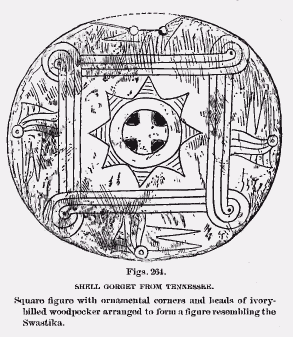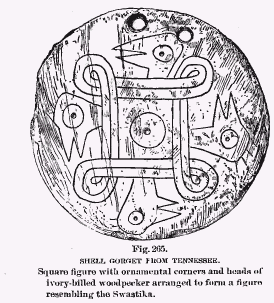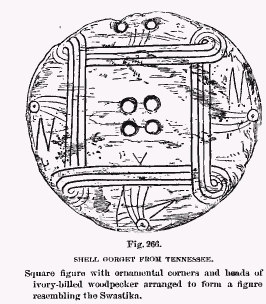

The Swastika
Forms Allied to the Swastika
 bureau
of Ethnology, 1880-81 (pl. 58), shows one of these shell gorgets form
Mississippi, which "was, in all probability, obtained from one of
the multitude of ancient sepulchres that abound in the State of Mississipi."
The design is engraved on the convex side, the perforations are placed
near the margin, and show much wear by the cord of suspension. In the
center is a nearly symmetrical Greek cross enclosed in a circle of 1 ¼
inches. The spaces between the arms are emblazoned with radiating lines.
Outside this circle are twelve small pointed or pyramidal rays. A square
framework of four continuous parallel lines looped at the corners encloses
this symbol; projecting from the center of each side of this square, opposite
the arms of the cross, are four heads of birds representing the ivory
billed woodpecker, the heron, or the swan. The long, slender, and straight
mandibles
bureau
of Ethnology, 1880-81 (pl. 58), shows one of these shell gorgets form
Mississippi, which "was, in all probability, obtained from one of
the multitude of ancient sepulchres that abound in the State of Mississipi."
The design is engraved on the convex side, the perforations are placed
near the margin, and show much wear by the cord of suspension. In the
center is a nearly symmetrical Greek cross enclosed in a circle of 1 ¼
inches. The spaces between the arms are emblazoned with radiating lines.
Outside this circle are twelve small pointed or pyramidal rays. A square
framework of four continuous parallel lines looped at the corners encloses
this symbol; projecting from the center of each side of this square, opposite
the arms of the cross, are four heads of birds representing the ivory
billed woodpecker, the heron, or the swan. The long, slender, and straight
mandibles  give
the Swastika form to the object. Mr. Holmes says (p. 282) that he has
been able to find six of these specimens, all of the type described, varying
only in detail, workmanship, and finish.
give
the Swastika form to the object. Mr. Holmes says (p. 282) that he has
been able to find six of these specimens, all of the type described, varying
only in detail, workmanship, and finish.Fig. 264, 265, and 266, (1) represent three of these shell gorgets. The first was obtained by Professor Putnam from a stone grave, Cumberland River, Tennessee. It is about 2 ½ inches in diameter and, like the former, it has a Greek cross in the center. The second was obtained by Mr. Cross from a stone grave near Nashville, Tenn. The third is from a stone grave near Oldtown, Tenn. All these have been drilled for suspension and are much worn.
The triskele, tirskleios, or triquetrum. --- These are Greek and Latin terms for the spiral volute with three branches or arms. The coins of Lycia were in this form, made originally by the junction of three cocks' heads and necks. The
 armorial
bearings of the island of Sicily, in ancient times, consisted of three
human legs joined at the thigh and flexed, sometimes booted and spurred.
(p. 873).
armorial
bearings of the island of Sicily, in ancient times, consisted of three
human legs joined at the thigh and flexed, sometimes booted and spurred.
(p. 873).Aboriginal shell gorgets have been found in the mounds of Tennessee and the adjoining country, which were engraved with this design, though always in spiral form. There seems to have been no distinction in the direction of the volutes, they turning indifferently to the right or to the left. Because of their possible relation to the Swastika it has been deemed proper to introduce them.
Fig. 267 (2) shows a Fulgur shell specimen obtained by Major Powell from a mound near Nashville, Tenn. It was found near the head of a skeleton. Its substance is well preserved; the surface was once highly polished, but now is pitted by erosion and discolored by age. The design is engraved on the concave surface as usual, the lines are accurately drawn and clearly cut. The central circle is three-eighths of an inch in diameter and is surrounded by a zone one-half an inch in width, which contains a triskelion or triquetrum of three voluted lines beginning near the center of the shell on the circumference of the inner circle of three small equidistant perforations, and sweeping outward spirally to the left as shown in the figure, making upward of half a revolution. These lines are somewhat wider and more deeply engraved than
ENDNOTES:
1. Second Ann. Rep. Bureau of Ethnology, p. 59. [Back]
2. Second Ann. Rep. Buereau of Ethnology, 1880-81, p. 273, pl. 54. Back
<< Previous Page Next Page >>
© 2004-2007 Northvegr.
Most of the material on this site is in the public domain. However, many people have worked very hard to bring these texts to you so if you do use the work, we would appreciate it if you could give credit to both the Northvegr site and to the individuals who worked to bring you these texts. A small number of texts are copyrighted and cannot be used without the author's permission. Any text that is copyrighted will have a clear notation of such on the main index page for that text. Inquiries can be sent to info@northvegr.org. Northvegr™ and the Northvegr symbol are trademarks and service marks of the Northvegr Foundation.

|